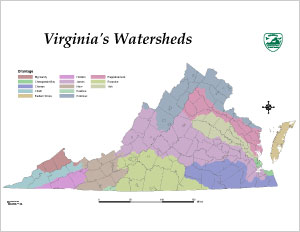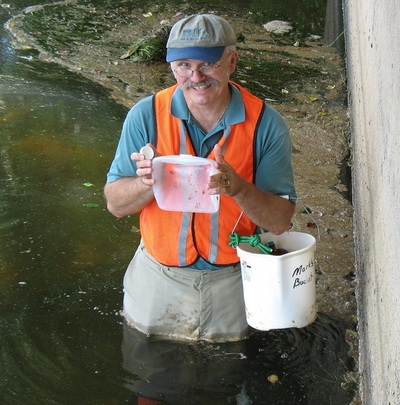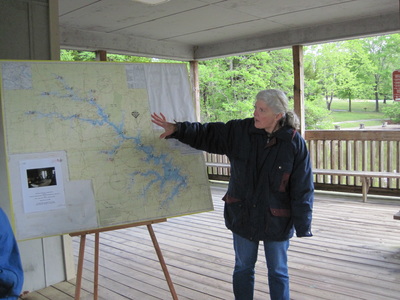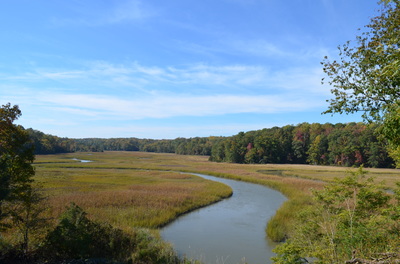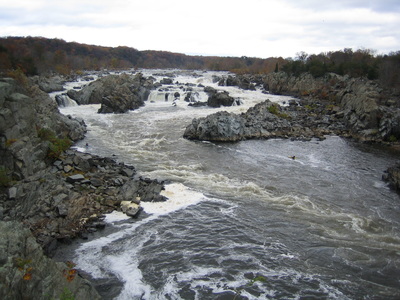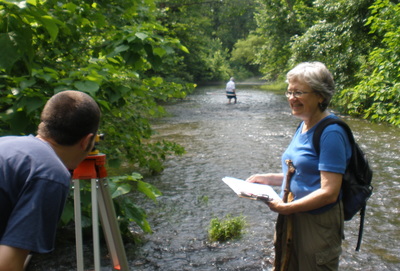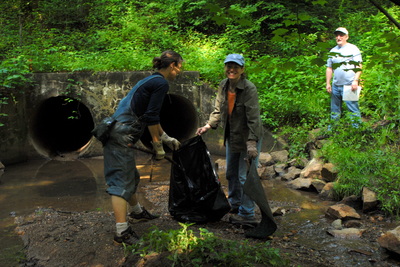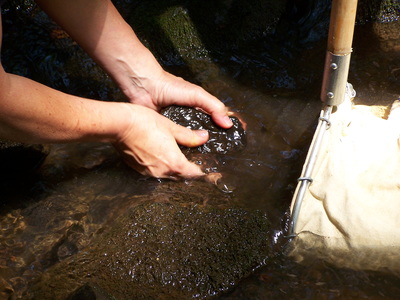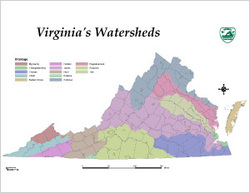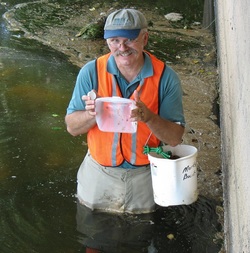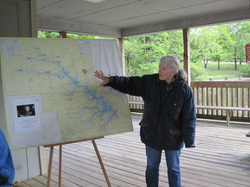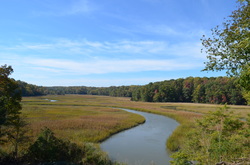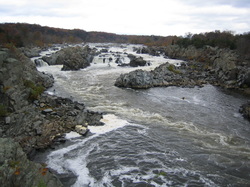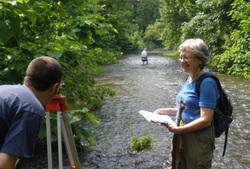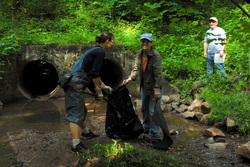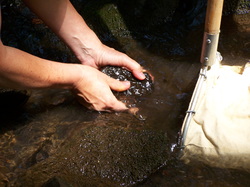Virginia Master Naturalist Basic Training Curriculum: Aquatic Ecology and Management
This page contains numerous curriculum resources that may be used flexibly by Virginia Master Naturalist chapters and trainees to meet their learning needs. These resources also are available to other volunteer programs and the public for their use, but please note that watching or reading these materials cannot substitute for enrolling in and completing a basic training course with a VMN chapter in order to become a Virginia Master Naturalist volunteer.
Thank you to the numerous people who contributed to the creation of these materials, including Page Hutchinson, Marilyn Smith, Anne Dunckel, James Beckley, Andrea Plevan, Ann Regn, Robert Hendricks, Mary Dail, Carolyn Thomas. Additional VMN volunteers and Creative Commons contributors provided images. Michelle Prysby, VMN Program Director, served as the lead author and project coordinator. Funding for the development of the Aquatic Ecology and Management curriculum was provided by a grant from the Virginia Environmental Endowment.
Learning Objectives | Introductory Videos | Background Readings | Presentation Videos |
Presentation Handout | Activity Lesson Plans | Assessment Questions | Evaluation Materials
Learning Objectives
Upon completion of the Virginia Master Naturalist basic training course, participants will understand and be able to describe:
- The definition of a watershed
- The major watersheds and rivers of Virginia, as well as their own “watershed address”
- Characteristics of the major types of freshwater aquatic systems (stream, rivers, ponds, lakes, and reservoirs) in Virginia
- Characteristics of groundwater and major aquifers in Virginia
- Basics of stream patterns, processes, and dynamics such as stream flow, sediment transport, baseflow, bankfull discharge, floodplains, meanders, riffles, and pools.
- Abiotic and biotic factors affecting surface water quality, including chemistry, flow, habitat structure, and energy inputs
- Aquatic food webs
- Key categories of organisms in freshwater aquatic systems, including benthic macroinvertebrates, freshwater mussels, and fish, and how these organisms can serve as biological indicators of water quality.
- Issues and threats relating to aquatic systems in Virginia, including point and non-point pollution, habitat loss, aquatic invasive species, and threats to groundwater such as contamination and subsidence.
- Key principles, tools, and methods for management of aquatic systems in Virginia, including the types of monitoring (physical, chemical, biological) volunteer groups may do.
- The roles of Virginia state and local agencies in managing aquatic systems
- The roles of citizens in the stewardship of aquatic systems in Virginia
- What a Meaningful Watershed Educational Experience is and how Master Naturalists can facilitate MWEEs in their communities
Participants also will be able to:
- Conduct basic water quality testing (physical, chemical, and/or biological), understand the data, and know what the data mean in relation to the waterbody being monitored
- Communicate with the public about the value of aquatic systems, the issues facing them, and what citizens can do to help
Introductory Videos
What: Short videos to introduce volunteers to the topic of Aquatic Ecology and Management.
Possible uses:
- Have trainees watch before class as preparation
- Watch as part of class
- Have trainees watch after class as review or supplementary material
- Have existing members watch as a refresher on this topic
- Citizen Water Quality Monitoring: An interview with James Beckley, Virginia Department of Environmental Quality
- Watch below or at video.vt.edu.
Bay 101: Stormwater Runoff, produced by the Chesapeake Bay Program. Watch the video below, or on the Chesapeake Bay Program website. (Creative Commons license, CC BY-NC 3.0, http://creativecommons.org/licenses/by-nc/3.0/legalcode)
Freshwater Mussels, produced by the Virginia Department of Game and Inland Fisheries
Virginia Water Radio Podcast – Water-quality Monitoring from a Trio of Perspectives
(For a transcript of this podcast episode, view it on the Virginia Water Radio website.)

This page contains numerous curriculum resources that may be used flexibly by Virginia Master Naturalist chapters and trainees to meet their learning needs. These resources also are available to other volunteer programs and the public for their use, but please note that watching or reading these materials cannot substitute for enrolling in and completing a basic training course with a VMN chapter in order to become a Virginia Master Naturalist volunteer. Thank you to the numerous people who contributed to the creation of these materials, including Page Hutchinson (VDOF), Marilyn Smith (VMN), Anne Dunckel (Alliance for the Bay), James Beckley (VDEQ), Andrea Plevan (Tetra Tech), Ann Regn (VDEQ), Robert Hendricks (VMN), Mary Dail (VDEQ), Carolyn Thomas (Ferrum College). Additional VMN volunteers and Creative Commons contributors provided images. Michelle Prysby, VMN Program Director, served as the lead author and project coordinator. Funding for the development of the Aquatic Ecology and Management curriculum was provided by a grant from the Virginia Environmental Endowment. |
Give us your feedback on these curriculum materials!
|
Learning Objectives
|
Introductory VideosWhat: Short videos to introduce volunteers to the topic of Aquatic Ecology and Management. Possible uses:
Citizen Water Quality Monitoring: An interview with James Beckley, Virginia Department of Environmental Quality
Watch below or at video.vt.edu. Bay 101: Stormwater Runoff, produced by the Chesapeake Bay Program. Watch the video below, or on the Chesapeake Bay Program website. (Creative Commons license, CC BY-NC 3.0, http://creativecommons.org/licenses/by-nc/3.0/legalcode)
Freshwater Mussels, produced by the Virginia Department of Game and Inland Fisheries
Virginia Water Radio Podcast – Water-quality Monitoring from a Trio of Perspectives
(For a transcript of this podcast episode, view it on the Virginia Water Radio website.) |
Background ReadingsMost Recommended Readings
Supplemental Readings
Above and Beyond, for those seeking more in-depth information
Benthic Macroinvertebrate Identification Resources
Additional Video and Podcast Resources
|
Presentation VideosWhat: A three-part set of online videos of PowerPoint presentations with narration by Michelle Prysby, Director of the Virginia Master Naturalist program. Combined, they are approximately 45 minutes long.
User Notes: Please note that you can make the video full-screen and toggle the closed captioning on and off. Please also note that these videos are intended to be used in conjunction with the handout provided below. You can also watch these videos at video.vt.edu: Part 1, Part 2, and Part 3. Note for Basic Training Chairs and Course Instructors: The script for the full Powerpoint presentation is provided below for download in MS Excel format, which makes it easy to add, delete, or re-order slides. Basic training chairs for VMN chapters may contact the state office for access to the full Powerpoint file. Both the Powerpoint and the script may be used and adapted for your courses. Please pay attention to the image license restrictions listed in the notes section for each slide in the Powerpoint file. VMN Aquatic Ecology and Management – Part 1
VMN Aquatic Ecology and Management Presentation – Part 2
VMN Aquatic Ecology and Management Presentation – Part 3
|
Presentation HandoutWhat: A two-page handout that matches up with the presentation. It is best printed in color, but black and white is acceptable. Possible uses: The handout is meant to accompany the PowerPoint presentation or the videos, so if an instructor is using the presentation in class, he/she should distribute the handout in lieu of a handout containing all the slides. It is not recommended that you print the slides for a handout, as they are almost entirely image-based and would not make good reference material. |
Activity Lesson PlansWhat: Lesson plans for interactive activities on aspects of aquatic ecology and management. Possible uses: These activities can be used during class time to encourage trainees to apply the material they have learned and to break up lecture time with an interactive exercise. The lesson plans are written so that they may be led by non-experts, including VMN volunteers. Activity #1: Exploring Virginia’s Watersheds. In this activity, participants will become familiar with Virginia’s major watersheds, find their own watershed addresses, and learn about impaired waterways in their communities.
Activity #2: A Snapshot in Time. This activity is from the Healthy Waters, Healthy People Water Quality Educators Guide by the Project WET Foundation. In the activity, participants examine water quality data from a hypothetical stream and learn to interpret it. We cannot post the lesson plan online, but we do have permission from the Project WET Foundation to share it directly with VMN chapters upon request for the purposes of VMN basic training. If you or your guest instructor would like to use this activity, please contact the statewide office and you will be provided with a link to download a PDF version.
|
Assessment QuestionsWhat: A set of possible assessment questions on this topic for VMN trainees. Possible uses: Incorporate these questions into written or practical assessments during the course. |
Evaluation MaterialsWhat: Evaluation packet consisting of a summary form to be completed by the chapter’s training chair and individual evaluation forms to be completed by chapter trainees. Possible uses: We would like to have you help us evaluate the effectiveness of these materials for meeting program goals. We request that chapters using any of these materials have their trainees complete the evaluation form. The training chair or coordinator for that class should complete the cover sheet and return the cover sheet and all individual forms to the VMN statewide program office. |

